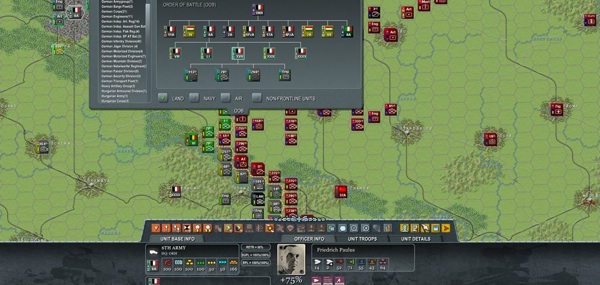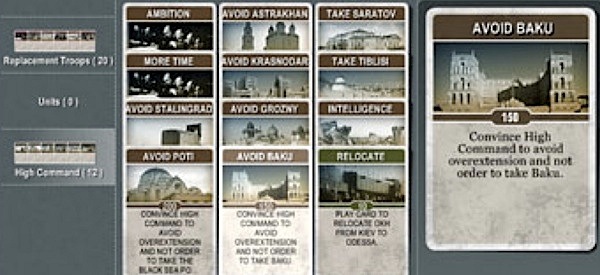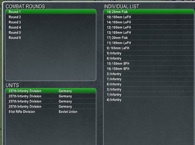Decisive Campaigns: Case Blue – PC Game Preview
 Decisive Campaigns: Case Blue. PC game preview. Designer: Victor Reijkersz, VR Games. Published by Matrix/Slitherine. $39.99
Decisive Campaigns: Case Blue. PC game preview. Designer: Victor Reijkersz, VR Games. Published by Matrix/Slitherine. $39.99
The preview of Decisive Campaigns: Case Blue used a pre-release version and may not reflect features present in the final release. However, no features appeared missing, no glaring spelling and grammar mistakes were noted, and all graphical interfaces were in place. No crashes occurred on the test bed: Velocity Micro PC running 32 bit Windows Vista SP2 with an E8500 Intel dual Core Duo @ 3.18 ghz, Gigabyte Nvidia GTX560Ti.
Decisive Campaigns: Case Blue is the second title in Decisive Campaigns series, with a new and improved game engine from the one debuted in Decisive Campaigns: From Warsaw To Paris.
{default}An operational strategy game set on Germany’s Eastern Front during its 1942 summer campaign toward Russia’s Caucuses oil fields, Case Blue is a fun and easily learned operational-level war game for armchair generals looking for a bit more realism without detailed micromanagement. There is some unit interface tedium, unfortunately, and combat results detail screens are not easily deciphered.
You are playing as the commander of either the German or Soviet OOB (below your respective High Commands). As the German player, you must drive to Stalingrad and into the Caucasus. As the Soviet, you must prevent the German goals and/or recapture Kiev and Odessa.

Operational level games of this type usually fall into two arenas. There are the beer-and-pretzels games such as the old Panzer General (or its modern version, Panzer Corps) and Battlefield Academy where fun comes first and logistics are mere shadows of reality. Then there is just about anything by Gary Grigsby—the massively detailed, grognard-beloved, monsters in which the player is as much a quartermaster as master tactician. Decisive Campaigns manages to tread a fine line between the two extremes. It remains an accessible and fun game, forces the armchair general to attend to logistical and organizational factors, and throws in a few new twists of its own.
As in many games of the genre, units are grouped into regiments, divisions, corps, and armies and reflect many different troop, equipment, and vehicle types for each side, with detailed statistics and artwork. The game maps range from 22×22 to 160×125 hexes depending on the scenario chosen. There are seven campaign scenarios: two versions of Case Blue (short and full), two of Operation Uranus (short and full), two named 2nd Kharkov and Trappenjagd, and a linked-scenario campaign called 1st Panzer Army. A full scenario editor is also included along with Play by Email options.
The game map is colorful but terrain graphics, while functional, are unimaginative and easily lost under the counters. Fortunately, you can cycle units with a mouse-click from standard NATO to silhouette or hide them entirely.
The units themselves are individually modeled: infantry, engineers, staff, artillery, rocket artillery, armor, trucks and halftracks, anti-tank guns, fighters, dive-bombers, level bombers, light FLAK, and heavy FLAK, and have various ratings for supply, morale, entrenchment, unit integrity, and readiness.

Units move by expending action points, individually or by stack, or via rail through strategic transfer points. Units shed action points as they move through terrain features, enemy zones of control, and other combat-ravaged areas. Fuel levels also directly affect movement costs and combat strength.
Organizational coherence is an important part of Decisive Campaigns, and it pays to keep your chains of command clean. Headquarters have a direct influence on your fighting ability, which decreases as your frontline units advance. Headquarters impart officer and staff bonuses—some potentially negative—to unit combat/hit point levels. Inefficient officers do exist and can become a detriment but can be replaced from an officer pool, though this may come at a price, depending on nationality or political requirements.
Another unique ability of HQs is the commanding officer can play "Officer Cards" that increase a selected unit’s movement, attack, defense, entrenchment level, and other advantages. This simulates the impact a Guderian or Manstein can have on a battle’s outcome. The number of times a particular officer can play a card, or the card’s effect, depends on several factors: his audacity, determination, charisma, intuition, etc. In turn, the quality of a commanding officer imparts modifiers to his staff, which in turn provides bonuses to units in the same organization.

Supply rules modeled by the computer will influence your decisions. Units will automatically request, and your HQs will try to fill, supplies needed to restore their readiness levels. When supplies are tight, you can adjust quiet sectors to 50% in order to free up resources for other units. Towns provide logistical bonuses in relationship to their size, so their capture becomes a priority. So will the fuel situation, as noted earlier.
Action points are used for both offensive actions and movement and can affected by various factors at either the unit or unit-stack level: stacking limits, readiness, supply, divisional bonus, experience, landscape, HQ/Staff mod, Action Cards, Concentric attacks, surprise, entrench, river penalty, depleted supply, and others. Combat itself devolves into rounds of fighting as each side is divided into groups of about 100 men or 5–10 vehicles and fights for as many rounds as the attacker has action points. Casualties are taken until one side or the other breaks, retreats, panics, or a combination thereof.
 At first glance, little makes Decisive Campaigns stand out from the many other war games on the market—until you experience its "High Command" rules. This reviewer has found most games inordinately constricting. Unless a scenario is hypothetical, victory is strictly determined by its real historical outcome and the player charged to "do as well as General So-and-So." Decisive Campaigns shakes up this model by throwing in some of the same variables and frustrations experienced by real German Eastern Front commanders—the meddling of OKW, the German High Command. This optional feature of the Decisive Campaigns series puts you in the position of that historical commander, with often difficult and unrealistic goals assigned by your superiors. Minor orders, up to four, can dictate a random offensive or defensive task such as capturing a town by a certain date or defending for a set number of days. Major orders are scripted and can force you into unrealistic situations based on OKW’s misreading of the facts at the front. Succeed at these orders and you gain prestige; fail continuously and you may find yourself dismissed. No doubt, this can lead to some frustration, but it is a welcome addition to the world of wargaming.
At first glance, little makes Decisive Campaigns stand out from the many other war games on the market—until you experience its "High Command" rules. This reviewer has found most games inordinately constricting. Unless a scenario is hypothetical, victory is strictly determined by its real historical outcome and the player charged to "do as well as General So-and-So." Decisive Campaigns shakes up this model by throwing in some of the same variables and frustrations experienced by real German Eastern Front commanders—the meddling of OKW, the German High Command. This optional feature of the Decisive Campaigns series puts you in the position of that historical commander, with often difficult and unrealistic goals assigned by your superiors. Minor orders, up to four, can dictate a random offensive or defensive task such as capturing a town by a certain date or defending for a set number of days. Major orders are scripted and can force you into unrealistic situations based on OKW’s misreading of the facts at the front. Succeed at these orders and you gain prestige; fail continuously and you may find yourself dismissed. No doubt, this can lead to some frustration, but it is a welcome addition to the world of wargaming.
The only real complaint has to do with the interface. Unit selection quickly became tedious. You can select units to move individually or by stack, but can during attacks. Once a target is selected you can either choose all units eligible to attack or individual units – nothing in between. Even units stacked in the same hex have to be selected individually and this takes two clicks per unit. Say you have a division of 4 brigades in a hex. Select the first brigade, then click a green arrow (which shows the unit has AP available to attack) to add the unit to your attack list. So, to add this single, four-brigade division to an attack takes a total of eight mouse clicks. Another issue this raises is that it is difficult to tell which units in a stack have AP remaining to allocate to an attack. You may get to the last brigade and find out that the odds are against a successful assault, so you decide to bring up another division. Sorry, but you will have to start over; bring up the other division and select each individual brigade in each of the two divisions. You could just hit "All" and then deselect those you do not want to allocate, but you will still wish there was a way to select all units in a stack with one click.
The combat results tables also seem a bit vague. Though you can tell quickly if you have won a fight or not, looking at the details screen for a clue as to exactly how you won is a mystery. The details tell you the result of each round of combat, but I was unable to find out if it was due to one of the many combat/officer modifiers or some other factor.
Aside from the somewhat tedious unit selection method, Decisive Campaigns: Case Blue is a worthy addition to the library of gamers who want just a little more realism than Panzer Corps provides. DCCB is quick-playing game that allows the armchair general to concentrate on his strategy and tactics without getting swamped with information on, and movement of, bullets and beans.
The details:
Complexity: Intermediate, Advanced
Players: 1-2
Min Spec: MINIMUM
OS: Windows XP (SP2), Windows Vista, Windows 7
CPU: 1.5 GHZ Processor or Equivalent (Running the game in higher resolution requires more processing power.)
RAM: 1.5 GB (XP), 2 GB (Vista / 7)
Video/Graphics: 8MB video memory
Sound: DirectX Compatible Sound Card
Hard disk space: 500 MB Free
DirectX version: Not required
NET Framework 2.0 Required (included)
Resolution: Variable, 1024 x 768 minimum
Multiplayer: PBEM++
About the Author
Neal West is a retired E-7 living in Southern Maryland. He has a BA in American Military History and expects to graduate with his Masters in Military History, Civil War concentration in November 2012. He began war gaming as a teen with such board classics as PanzerBlitz, Jutland, and Rise and Fall of the Third Reich before graduating to computers with Chris Crawford’s Eastern Front 1941 on the Atari 800. Throughout the ’80s and ’90s he crushed his enemies, saw them driven before him, and heard the lamentation of their women (and sometimes their men) through most of the old SSI and Microprose catalog of games. Today, he’s playing a lot of Panzer Corps and World of Tanks.


The preview was a nice read.
A small piece of advice on easy interface use. Especially in unit heavy scenarios.
Use the hotkeys.
The keys ‘M’, ‘A’ and ‘SPACE’ and ‘ESC’ are your biggest friend ever in this game.
This way you can select a unit on the map and then instead of moving the mouse again, just press ‘M’, then click the target hex (quite near it). If you want to abort the move you can press ‘ESC’ or ‘SPACE’ and select a different unit instead and repeat the process.
With attack. You select a hex, and leave the mouse for what it is and then press ‘A’. The attack is then initiated. Then start clicking on units in the surrounding hexes and if you want a selected unit to join press ‘SPACE’ and ‘SPACE’ again to unjoin it. ‘ESC’ to break off the attack, for launching the attack you still have to click the attack button with the mouse though. This work especially well in zoomed in mode with small counters so you dont have to click through stacks.
Best,
Vic
Thanks Vic, in an attempt to get the review out before your release date, I was not able to spend as much time as I would have liked with Case Blue. I apologize for any errors or ignorance of the game system mechanics!
Does this size properly for large monitors, or is the text font unreadably small (and unchangable) like TOAW? I had to get a larger monitor to compensate for vision problems, and was really sad to find out that TOAW was now unplayable, and they simply don’t give a damn about vision-impaired customers…
Loydb,
I play it on a 47″ monitor at 1920×1080. Text is fairly readable when the map is zoomed out and perfectly readable when zoomed. I supplied many more screenshots to ACG but they only used 3.
BTW about recommended books. There are no authors like Bieschanow, or Solonin. Why ?